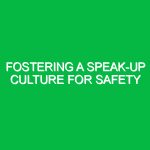Introduction
Bullying and harassment are pervasive issues that can severely impact individuals and organizations, particularly in the Health, Safety, and Environment (HSE) domain. Addressing bullying and harassment is not merely a moral imperative; it is essential for fostering a safe and productive workplace. In this article, we will explore the relevance of this issue, identify potential hazards and risks, and provide actionable strategies for effective management and prevention.
Understanding Bullying and Harassment in HSE
Bullying involves repeated, aggressive behavior that intentionally harms another individual, while harassment encompasses unwelcome conduct based on characteristics such as race, gender, or disability. In the HSE context, these behaviors can manifest in various forms, including verbal abuse, intimidation, and exclusion from essential work activities. Both bullying and harassment create a toxic work environment that can hinder productivity, increase turnover rates, and even compromise safety protocols.
Identifying Hazards and Risks
Addressing bullying and harassment is crucial because of the numerous hazards and risks associated with these behaviors. These can include psychological distress, decreased job satisfaction, and increased absenteeism. More critically, they can lead to physical harm if employees are distracted or stressed due to an unhealthy workplace atmosphere.
Psycho-Social Hazards
Psycho-social hazards are significant in the HSE domain. Employees exposed to bullying may experience anxiety, depression, and stress-related disorders. For instance, a colleague’s constant derogatory remarks can create a hostile environment, leading to decreased morale and productivity. Furthermore, individuals who feel unsafe are less likely to report safety violations, which can lead to catastrophic incidents.
Physical Safety Risks
When employees are preoccupied with the emotional toll of harassment, they may become less vigilant regarding safety protocols. An example can be drawn from the construction industry, where a worker experiencing bullying may not focus adequately on safety measures, leading to accidents or injuries. Thus, the link between psychological well-being and physical safety cannot be overstated.
Best Practices for Addressing Bullying and Harassment
To effectively address bullying and harassment in the HSE domain, organizations should adopt comprehensive strategies that prioritize prevention, intervention, and support. Here are some best practices:
Establish Clear Policies
Organizations must develop clear anti-bullying and harassment policies that define unacceptable behaviors, outline reporting procedures, and specify consequences for violations. These policies should be communicated effectively across all levels of the organization. For example, a manufacturing company might implement a zero-tolerance policy that is prominently displayed in break rooms and included in employee handbooks.
Training and Awareness Programs
Regular training sessions should be conducted to raise awareness about bullying and harassment. These programs should educate employees on recognizing the signs of bullying, understanding its effects, and knowing how to report incidents. For instance, a healthcare facility might hold workshops that allow staff to role-play scenarios, helping them to react appropriately in real-life situations.
Encourage Open Communication
A culture of open communication is vital. Employees should feel safe to voice their concerns without fear of retribution. Establishing anonymous reporting mechanisms can help. For example, an environmental services company could introduce a confidential hotline for employees to report bullying or harassment, ensuring that their concerns are taken seriously.
Provide Support Systems
Support systems, such as counseling services or employee assistance programs (EAPs), can be invaluable for affected individuals. Providing access to mental health resources can help employees cope with the emotional fallout of bullying. A real-life example is a large engineering firm that offers on-site counseling services, allowing employees to seek help discreetly and conveniently.
Safety Precautions and Actionable Advice
Addressing bullying and harassment requires proactive measures. Here are some actionable safety precautions that organizations should implement:
Regular Risk Assessments
Conducting regular risk assessments can help identify potential bullying and harassment hotspots within the organization. This process should include surveys and interviews with staff to gather feedback on workplace culture and areas of concern. For instance, a transportation company might discover through surveys that certain departments have higher incidences of reported bullying, prompting targeted interventions.
Implementing a Reporting Mechanism
Designing an efficient reporting mechanism can significantly enhance the organization’s ability to tackle bullying and harassment. Employees should be able to report incidents easily and confidentially. An online platform where employees can submit their complaints can streamline this process. For example, a tech firm introduced a user-friendly online portal that allows employees to report issues anonymously, which led to a significant increase in reported incidents and subsequent investigations.
Monitoring Work Environment
Active monitoring of the work environment is critical. Managers should be trained to recognize signs of bullying and harassment and to take immediate action. Regular check-ins with staff can help gauge the workplace atmosphere. For example, a retail chain implemented weekly team huddles to discuss any concerns, which fostered a sense of community and openness.
Regulations and Standards Governing Bullying and Harassment
Regulatory frameworks play a vital role in addressing bullying and harassment. Various laws govern workplace behavior, ensuring organizations take these issues seriously. Some key regulations include:
Occupational Safety and Health Administration (OSHA) Standards
Under OSHA standards, employers are required to provide a safe work environment. This includes protecting employees from workplace harassment and bullying, which can lead to psychological and physical harm. Organizations must comply with OSHA guidelines to avoid penalties and ensure employee welfare.
Equal Employment Opportunity Commission (EEOC) Guidelines
The EEOC provides guidelines that prohibit harassment based on race, color, religion, sex, national origin, age, disability, or genetic information. Employers must take proactive measures to prevent harassment and respond effectively to complaints, reinforcing the importance of a respectful workplace.
Conclusion
Addressing bullying and harassment in the HSE domain is not just a legal obligation; it is a fundamental aspect of creating a healthy workplace culture. By recognizing the risks, implementing effective strategies, and adhering to regulatory standards, organizations can foster a safe and supportive environment for all employees. Ultimately, a commitment to addressing bullying and harassment not only enhances workplace safety but also promotes employee well-being and organizational success.


